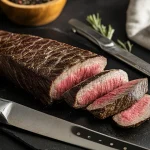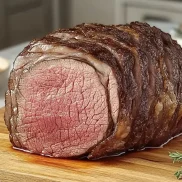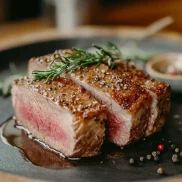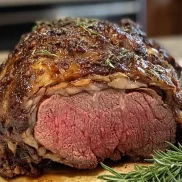Beef tenderloin is often regarded as the most prized cut of beef, known for its exceptional tenderness and rich flavor. Whether you’re preparing an elegant dinner or treating yourself to a gourmet meal, this premium cut offers an unparalleled dining experience. But which cooking method is best for beef tenderloin? Before exploring the ideal ways to cook it, it’s important to understand what makes beef tenderloin so special—its unique texture, flavor profile, and nutritional value. If you’re looking for inspiration on preparing smaller portions of this exquisite cut, check out our beef tenderloin tips recipe. Gaining insight into these aspects will help you make informed choices and achieve the perfect dish every time.
Table of Contents
Understanding Beef Tenderloin
To truly appreciate beef tenderloin, it’s important to understand where it comes from and what sets it apart from other cuts. This section will delve into its origin, texture, and overall appeal to help you get a comprehensive view of this prized cut of meat.
What Is Beef Tenderloin?
Beef tenderloin is a long, narrow muscle that runs along the spine of the cow, nestled between the sirloin and the short loin. This specific location is why it’s so tender – the muscle does minimal work during the cow’s life, resulting in an incredibly soft and buttery texture. Unlike tougher cuts, beef tenderloin doesn’t require lengthy cooking methods to break down connective tissues, making it an ideal choice for quick yet elegant meals.
This cut is often portioned into steaks, such as filet mignon, or roasted whole for a show-stopping centerpiece. Its mild flavor pairs well with a variety of seasonings and cooking techniques, allowing home cooks and chefs alike to experiment with confidence.
Key Characteristics of Beef Tenderloin
One of the defining traits of beef tenderloin is its unmatched tenderness. This characteristic is a direct result of its anatomical location, as mentioned earlier. When cooked correctly, it practically melts in your mouth. The texture is smooth and fine-grained, making it a favorite for those who prioritize tenderness over fattiness.
In terms of appearance, beef tenderloin is cylindrical, with a uniform shape that makes it easy to handle and cook evenly. While it’s relatively lean compared to cuts like ribeye, it still retains enough marbling to provide a rich, succulent flavor. This balance between leanness and flavor makes it versatile, appealing to a wide range of culinary preferences.
Nutritional Profile of Beef Tenderloin
For those mindful of their diet, beef tenderloin offers a nutritious option without compromising on taste. It’s a lean cut, meaning it’s lower in fat and calories compared to other premium cuts like ribeye or T-bone. A 3-ounce serving of beef tenderloin typically contains about 23 grams of protein, making it an excellent choice for those looking to meet their daily protein needs.
Additionally, beef tenderloin is a good source of essential vitamins and minerals, including iron, zinc, and B vitamins like niacin and vitamin B12. These nutrients play crucial roles in energy production, immune support, and overall well-being. However, because it’s a leaner cut, it’s important to be mindful of cooking techniques that preserve its natural juices and prevent it from drying out.
Understanding these aspects of beef tenderloin not only highlights its appeal but also sets the stage for exploring the best cooking methods to enhance its flavor and texture.
Which Cooking Method Is Best for Beef Tenderloin? A Comparison of Techniques
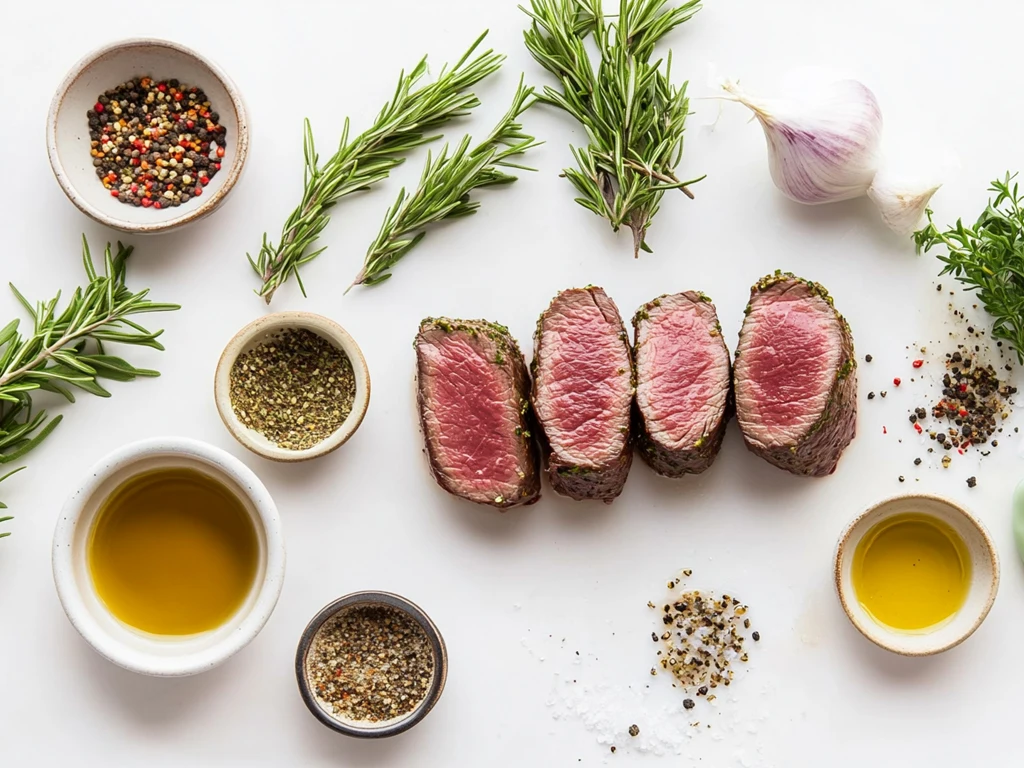
Cooking beef tenderloin is an art that requires understanding and finesse. With its natural tenderness and delicate flavor, this cut shines brightest when prepared with care. Choosing the right cooking method not only enhances its taste but also ensures the perfect texture and juiciness. Here, we’ll evaluate popular cooking techniques and the factors to consider when deciding how to prepare this exquisite cut.
Overview of Popular Cooking Techniques
Beef tenderloin’s versatility allows for a range of cooking methods, each bringing its unique flavor and texture to the table. The most common techniques include:
- Grilling: A timeless favorite, grilling imparts a smoky, charred flavor to the tenderloin. It’s ideal for outdoor gatherings and pairs well with marinades or dry rubs.
- Roasting: Perfect for whole beef tenderloin, roasting provides even heat distribution, resulting in a juicy interior and a beautifully browned crust.
- Sous Vide: This method offers unparalleled precision, cooking the tenderloin to the exact desired temperature. It ensures maximum tenderness and is often finished with a quick sear for added flavor.
- Pan-Searing: Quick and efficient, pan-searing creates a golden, caramelized crust. It’s a great option for smaller cuts like filet mignon.
- Broiling: Using high, direct heat, broiling is perfect for achieving a charred exterior and a juicy interior. It’s especially useful in the absence of a grill.
- Slow Cooking: For those seeking a melt-in-your-mouth experience, slow cooking transforms tenderloin into an ultra-tender, flavorful dish. While unconventional, it’s excellent for recipes like shredded beef tenderloin.
Each technique offers distinct advantages, and the choice often depends on the occasion, available equipment, and personal preferences.
Factors to Consider When Choosing a Method
Selecting the best cooking method for beef tenderloin involves weighing several factors. Here’s what to keep in mind:
- Cut Size and Shape:
- Whole beef tenderloin is best suited for roasting or sous vide to ensure even cooking.
- Smaller portions like medallions or steaks excel with grilling, pan-searing, or broiling.
- Desired Flavor Profile:
- For a smoky taste, opt for grilling or broiling.
- To preserve the beef’s natural flavor, sous vide or roasting is ideal.
- Cooking Experience:
- Sous vide requires specialized equipment but minimizes the risk of overcooking.
- Pan-searing and grilling demand attentiveness and timing to achieve optimal results.
- Available Time:
- Quick methods like grilling and pan-searing are great for busy schedules.
- Slow cooking or sous vide requires more time but rewards with exceptional tenderness.
- Serving Style:
- For formal dinners, roasted tenderloin makes an impressive centerpiece.
- Casual meals might call for grilled steaks or broiled medallions.
Understanding these factors helps tailor the cooking method to your needs, ensuring that every bite of beef tenderloin is a culinary triumph. The next sections will explore these techniques in detail, highlighting their steps, advantages, and tips for perfection.
Grilling: A Classic Choice
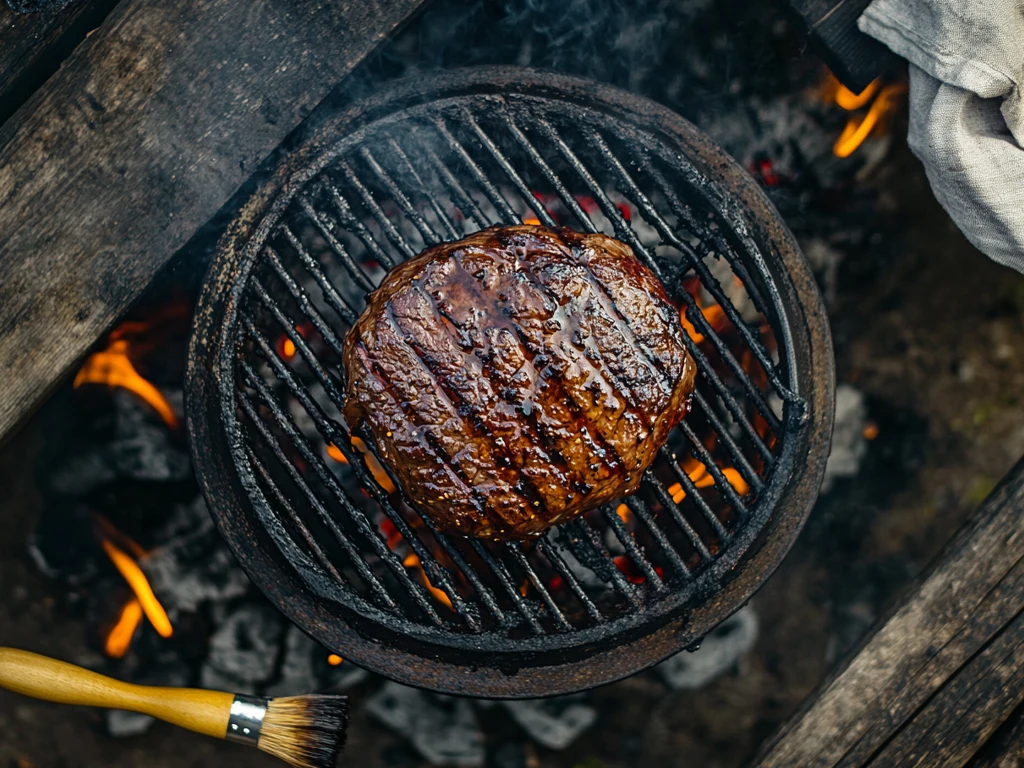
Grilling beef tenderloin is a time-honored method that brings out its natural flavors while adding a smoky, charred finish. This cooking technique is perfect for outdoor gatherings, offering a delightful combination of simplicity and elegance. When done right, grilling enhances the tenderloin’s taste and texture, creating a memorable dining experience.
Benefits of Grilling Beef Tenderloin
Grilling is a popular choice for beef tenderloin for several reasons:
- Smoky Flavor: Grilling infuses the meat with a rich, smoky aroma that’s hard to replicate with other methods. The direct heat caramelizes the surface, creating a savory crust that locks in the juices.
- High Heat Efficiency: Grills provide consistent, high heat, ideal for searing the tenderloin and achieving a perfectly cooked interior.
- Outdoor Appeal: Grilling is synonymous with outdoor gatherings and celebrations. It’s a social activity that adds a fun and festive element to any meal.
- Versatility: Whether you’re using a charcoal, gas, or pellet grill, each option imparts its unique flavor to the beef tenderloin. Additionally, grilling accommodates a variety of seasonings, marinades, and rubs, allowing for endless customization.
Overall, grilling is an excellent way to enhance the natural qualities of beef tenderloin while offering a unique flavor profile that elevates the dish.
How to Prepare Beef Tenderloin for Grilling
Preparation is key to achieving a mouthwatering grilled beef tenderloin. Follow these steps for optimal results:
- Choose the Right Cut: Select a whole beef tenderloin or pre-portioned steaks. Ensure the meat is fresh and of high quality.
- Trim the Fat and Silver Skin: Remove any excess fat and the silver skin to prevent uneven cooking and tough bites.
- Season Generously: Apply a generous amount of salt and pepper to enhance the natural flavors. For added complexity, use a dry rub or marinade featuring garlic, rosemary, and olive oil.
- Bring to Room Temperature: Allow the meat to sit at room temperature for 30 minutes before grilling. This ensures even cooking and prevents the exterior from overcooking while the interior warms up.
- Preheat the Grill: Heat the grill to medium-high, ensuring the grates are clean and well-oiled to prevent sticking.
- Sear and Cook: Sear the tenderloin over direct heat for 2-3 minutes per side, then move it to indirect heat to finish cooking. Use a meat thermometer to monitor the internal temperature: 130°F for medium-rare and 140°F for medium.
- Rest Before Slicing: Let the meat rest for 10-15 minutes after grilling. This allows the juices to redistribute, ensuring a juicy and tender result.
Common Mistakes to Avoid When Grilling
Grilling beef tenderloin can be straightforward, but avoiding these common pitfalls will ensure a perfect outcome:
- Skipping the Preheat: Always preheat the grill to avoid uneven cooking and sticking.
- Overcooking: Tenderloin is a lean cut and can become dry if overcooked. Use a thermometer to achieve the desired doneness.
- Turning Too Frequently: Let the meat sear properly before flipping to develop a crust and retain juices.
- Neglecting Rest Time: Skipping the resting period can cause the juices to run out, leaving the meat dry.
- Using Too Much Heat: While high heat is excellent for searing, cooking the entire tenderloin over direct heat can result in an over-charred exterior and an undercooked interior.
By following these tips, grilling beef tenderloin becomes a foolproof method for creating a delicious and satisfying meal. The smoky flavor and tender texture make it a standout choice for any occasion.
Roasting: A Crowd Favorite
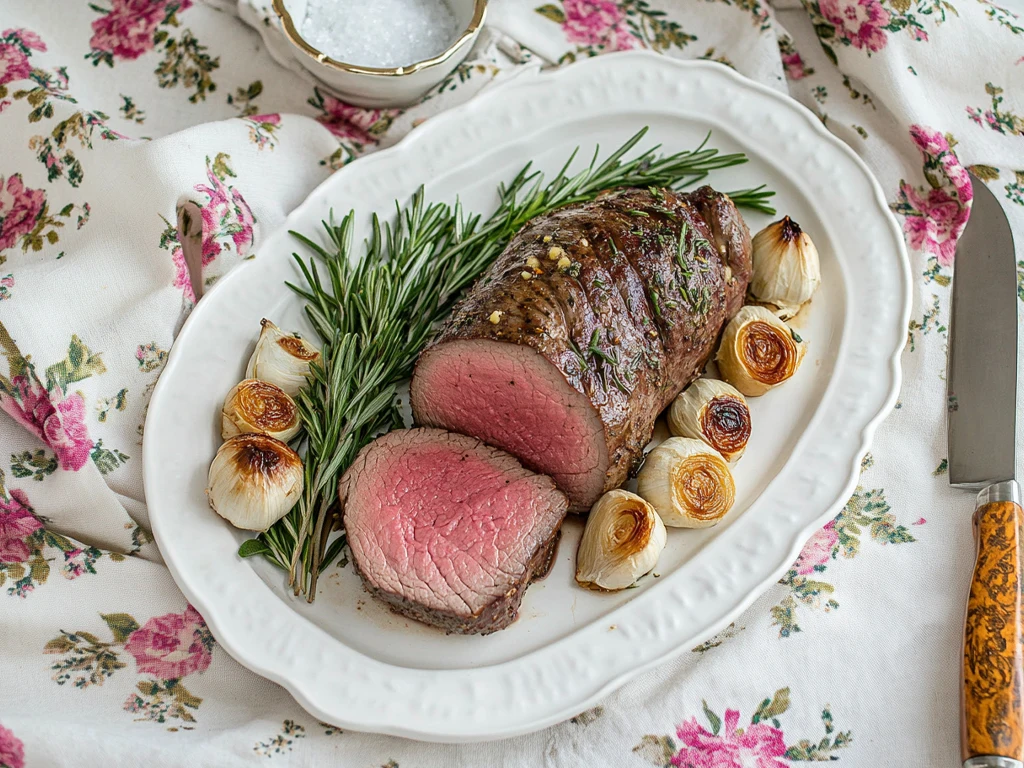
Roasting beef tenderloin is a classic method that highlights its natural tenderness and allows its rich flavors to shine. This technique is ideal for special occasions and dinner parties, offering a beautiful presentation and consistent results. Roasting requires minimal effort while delivering maximum flavor, making it a crowd-pleasing choice for both novice and experienced cooks.
Why Roasting Enhances Beef Tenderloin Flavor
Roasting is a dry-heat cooking method that brings out the best in beef tenderloin. Here’s why it’s so effective:
- Even Cooking: By surrounding the tenderloin with hot, circulating air, roasting ensures uniform cooking throughout the cut. This results in a juicy, tender interior and a beautifully caramelized crust.
- Concentrated Flavor: The slow, gentle heat of roasting allows the natural juices and flavors of the tenderloin to intensify, creating a savory and satisfying taste.
- Customizable Seasoning: Roasting provides the perfect canvas for various herbs, spices, and marinades, allowing you to tailor the flavor profile to your liking.
- Impressive Presentation: A whole roasted beef tenderloin makes for an elegant centerpiece, perfect for festive gatherings or celebratory meals.
These benefits make roasting a go-to method for showcasing the exceptional qualities of beef tenderloin.
Step-by-Step Roasting Guide
Follow these steps to achieve a perfectly roasted beef tenderloin:
- Select the Cut: Choose a whole beef tenderloin or a trimmed portion, depending on the number of servings required. Ensure the meat is fresh and high-quality.
- Prepare the Meat: Trim any excess fat and remove the silver skin. Pat the tenderloin dry with paper towels to ensure a good sear.
- Season Generously: Rub the tenderloin with a mixture of olive oil, salt, pepper, and your choice of herbs such as thyme or rosemary. Garlic and Dijon mustard can also add depth to the flavor.
- Preheat the Oven: Set your oven to 425°F (220°C). A hot oven is crucial for achieving a caramelized crust.
- Sear for Flavor: Heat a skillet over high heat and sear the tenderloin on all sides until browned. This step locks in the juices and enhances the flavor.
- Roast to Perfection: Transfer the seared tenderloin to a roasting pan or baking sheet. Roast in the oven until the internal temperature reaches 130°F for medium-rare or 140°F for medium.
- Rest the Meat: Let the tenderloin rest for 15 minutes after removing it from the oven. This allows the juices to redistribute, ensuring every bite is moist and flavorful.
- Slice and Serve: Use a sharp knife to slice the tenderloin into even portions. Serve with your choice of sides and garnishes.
Ideal Roasting Temperatures and Times
Cooking times and temperatures are critical for a perfect roast. Use this table as a guideline:
| Desired Doneness | Internal Temperature | Approximate Cooking Time |
|---|---|---|
| Rare | 120°F (49°C) | 20-25 minutes |
| Medium-Rare | 130°F (54°C) | 25-30 minutes |
| Medium | 140°F (60°C) | 30-35 minutes |
| Medium-Well | 150°F (66°C) | 35-40 minutes |
Remember, these times are based on a 2-3 pound tenderloin roasted at 425°F. Always use a meat thermometer to check for doneness, as oven performance can vary.
Roasting beef tenderloin is a straightforward and rewarding method that delivers a delectable dish every time. With its impressive presentation and unmatched flavor, it’s no wonder roasting is a perennial favorite.
Searing and Sous Vide: The Gourmet Approach
Combining sous vide and searing is a game-changer for preparing beef tenderloin, offering unmatched precision and a restaurant-quality finish. This method leverages the science of controlled water-bath cooking followed by a quick, high-heat sear to achieve the perfect texture and flavor. It’s a favorite among gourmet chefs and home cooks aiming for culinary perfection.
The Science Behind Sous Vide Beef Tenderloin
Sous vide, which means “under vacuum” in French, involves cooking food in a vacuum-sealed bag submerged in a temperature-controlled water bath. This technique ensures precise, even cooking and eliminates the guesswork often associated with traditional methods. Here’s how it works for beef tenderloin:
- Temperature Precision: The water bath is set to the exact desired internal temperature of the meat. For example, if you prefer medium-rare beef tenderloin, set the sous vide device to 130°F (54°C). This guarantees that the tenderloin will be perfectly cooked edge to edge.
- Juice Retention: Because the tenderloin cooks slowly at a consistent temperature, the juices remain locked inside, resulting in an incredibly moist and tender piece of meat.
- Enhanced Flavor: Cooking the tenderloin in a sealed bag with herbs, spices, or butter allows the flavors to infuse deeply without escaping.
The sous vide process is a foolproof way to prepare beef tenderloin, particularly for those seeking exacting results with minimal effort.
How to Combine Searing with Sous Vide
While sous vide creates the perfect interior, a quick sear adds the essential finishing touch: a flavorful crust. Here’s how to combine the two techniques for exceptional results:
- Prepare the Tenderloin: Season the tenderloin generously with salt, pepper, and any preferred herbs or aromatics. Place it in a vacuum-sealable bag with a pat of butter or a drizzle of olive oil.
- Sous Vide Cooking: Submerge the sealed bag in the water bath, ensuring the tenderloin is fully covered. Cook at your chosen temperature for 1-4 hours, depending on the thickness of the meat.
- Remove and Dry: Once the sous vide process is complete, remove the tenderloin from the bag and pat it dry with paper towels. A dry surface is essential for achieving a good sear.
- Sear to Perfection: Heat a skillet over high heat and add a splash of oil or butter. Sear the tenderloin for 1-2 minutes per side, ensuring a golden-brown crust forms.
- Rest and Serve: Let the tenderloin rest for a few minutes before slicing and serving to allow the juices to redistribute.
This combination method delivers the best of both worlds: the precision of sous vide and the irresistible flavor of a seared crust.
Pros and Cons of Sous Vide for Beef Tenderloin
Every cooking method has its advantages and limitations, and sous vide is no exception. Here’s a balanced look at the pros and cons:
Pros:
- Unparalleled Precision: Achieve the exact doneness every time, with no risk of overcooking.
- Enhanced Moisture: Retains natural juices for a tender and succulent result.
- Convenience: Minimal hands-on time allows you to focus on other meal preparations.
- Consistency: Even cooking throughout ensures no overdone or undercooked sections.
Cons:
- Special Equipment Required: A sous vide device and vacuum sealer are necessary, which may not be readily available in all kitchens.
- Time-Consuming: While mostly hands-off, the process can take longer than traditional methods.
- Limited Browning: Sous vide doesn’t provide a seared crust, necessitating an additional step.
Despite these considerations, the sous vide and searing combination remains one of the most reliable and rewarding methods for preparing beef tenderloin. It’s perfect for those aiming to elevate their culinary skills and deliver an unforgettable dining experience.
Frequently Asked Questions
What are beef tenderloin tips good for?
Beef tenderloin tips are incredibly versatile and perfect for a variety of dishes. Their tender texture makes them ideal for quick cooking methods such as stir-frying, sautéing, or grilling. They’re also excellent for recipes that call for smaller, bite-sized pieces of meat, like beef stroganoff, kabobs, or steak salads. Because they come from the same muscle as the tenderloin, they retain the rich flavor and tenderness of the larger cut, making them a cost-effective choice for gourmet meals. Learn more
Are beef tenderloin tips tender?
Yes, beef tenderloin tips are exceptionally tender. They come from the tapered end or trimmings of the beef tenderloin, which is known as the most tender cut of beef. This part of the muscle does little work, resulting in a buttery-soft texture. Proper cooking methods, such as searing, grilling, or sautéing, further enhance their tenderness, ensuring a delightful dining experience. Learn more
Are tenderloin tips the same as filet mignon?
No, tenderloin tips and filet mignon are not the same, though they come from the same muscle. Filet mignon refers to the thick, center-cut portion of the beef tenderloin, prized for its uniform shape and exceptional tenderness. Tenderloin tips, on the other hand, are smaller pieces trimmed from the ends or edges of the tenderloin. While they share the same tenderness, tenderloin tips are more irregular in shape and are often used in recipes requiring smaller cuts of beef. Learn more
What is the best cooking method for beef tenderloin?
The best cooking method for beef tenderloin depends on your preferences and the occasion. Popular options include roasting for an even, caramelized crust, grilling for a smoky charred flavor, and sous vide for precise temperature control. Each method highlights the tenderloin’s natural tenderness and rich flavor, so the choice ultimately comes down to your desired taste and texture.
How do you keep beef tenderloin from drying out?
To prevent beef tenderloin from drying out, use cooking methods that retain moisture, such as roasting, sous vide, or grilling with proper techniques. Always allow the tenderloin to rest after cooking to redistribute its juices. Using a meat thermometer to monitor internal temperature ensures the meat doesn’t overcook. For added moisture, consider basting the tenderloin with butter or cooking it in a flavorful marinade.
Is beef tenderloin worth the cost?
Absolutely! Beef tenderloin is considered a premium cut of meat due to its unparalleled tenderness and mild flavor. While it’s more expensive than other cuts, its versatility and luxurious texture make it worth the investment for special occasions or gourmet meals. Proper preparation and cooking can help you get the most value from this exquisite cut.
Conclusion
When it comes to answering the question, Which cooking method is best for beef tenderloin, the answer ultimately depends on your preferences, available equipment, and the dining experience you’re aiming to create. From the smoky allure of grilling to the precise control of sous vide and the classic appeal of roasting, each method brings its unique flair to this luxurious cut.
Understanding the characteristics of beef tenderloin and tailoring the cooking technique to your needs ensures a perfectly tender and flavorful result every time. Whether you’re hosting a formal dinner or preparing a casual meal, choosing the right method can elevate your dish to gourmet levels.
Now that you have a comprehensive guide, it’s time to roll up your sleeves and try these techniques yourself. With a little practice and the right approach, you’ll be able to master the art of cooking beef tenderloin, delighting your guests and savoring every bite of this exceptional cut.

